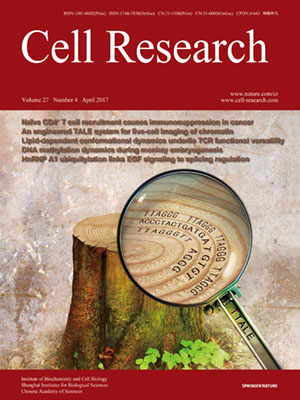
Volume 27, No 4, Apr 2017
ISSN: 1001-0602
EISSN: 1748-7838 2018
impact factor 17.848*
(Clarivate Analytics, 2019)
Volume 27 Issue 4, April 2017: 578-581 | Open Access
ORIGINAL ARTICLES
Efficient generation of mice carrying homozygous double-floxp alleles using the Cas9-Avidin/Biotin-donor DNA system
Ming Ma1,*, Fengfeng Zhuang2,*, Xiongbing Hu2, Bolun Wang1, Xian-Zi Wen3, Jia-Fu Ji3 and Jianzhong Jeff Xi1,4,5
1Department of Biomedical Engineering, State Key Laboratory of Natural and Biomimetic Drugs, College of Engineering, Peking University, Beijing, China
2Beijing Viewsolid Biotech Co. Ltd, Beijing 100071, China
3Division of Gastrointestinal Cancer Translational Research Laboratory, Department of Gastrointestinal Surgery, Key Laboratory of Carcinogenesis and Translational Research (Ministry of Education), Peking University Cancer Hospital & Institute, Fu-Cheng Road, Beijing, China
4State Key Laboratory of Biomembrane and Membrane Biotechnology, Institute of Molecular Medicine, Peking University, Beijing 100871, China
5Collaborative Innovation Center for Cardiovascular Disorders, Beijing Institute of Heart Lung and Blood Vessel Diseases, Beijing 100029, China
Correspondence: Jia-Fu Ji, Tel: 86-10-88196709
E-mail: jijiafu@hsc.pku.edu.cn; Jianzhong Jeff Xi, Tel: 86-10-62760698 (jzxi@pku.edu.cn)
The clustered, regularly interspaced, short palindromic repeats (CRISPR)/CRISPR-associated protein 9 (Cas9) system is a versatile tool for genomic engineering in mammalian cells and organisms, enabling the introduction of site-specific genomic double-strand breaks (DSBs)1. The resulting DSBs are repaired by at least two distinct and competitive mechanisms, nonhomologous end-joining (NHEJ) and homology-directed repair (HDR). The former results in insertions and deletions (indels), whereas the latter leads to precise genetic modification.
10.1038/cr.2017.29
FULL TEXT | PDF
Browse 1779


